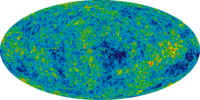
Photo from wikipedia
Abstract In recent work, radar circular polarization echo properties have been used to identify secondary craters without distinctive “secondary” morphologies. Because of the potential for this method to improve our… Click to show full abstract
Abstract In recent work, radar circular polarization echo properties have been used to identify secondary craters without distinctive “secondary” morphologies. Because of the potential for this method to improve our knowledge of secondary crater populations—in particular the effect of secondary populations on crater-derived ages based on small craters—it is important to understand the origin of radar polarization signatures associated with secondary impacts. In this paper, we utilize Lunar Reconnaissance Orbiter Camera photographs to examine the geomorphology of secondary craters with radar circular polarization ratio enhancements. Our investigation reveals evidence of dry debris flow with an impact melt component at such secondary craters. We hypothesize that these debris flows were initiated by the secondary impacts themselves, and that they have entrained blocky material ejected from the secondaries. By transporting this blocky material downrange, we propose that these debris flows (rather than solely ballistic emplacement) are responsible for the tail-like geometries of enhanced radar circular polarization ratio associated with the secondary craters investigated in this work. Evidence of debris flow was observed at both clustered and isolated secondary craters, suggesting that such flow may be a widespread occurrence, with important implications for the mixing of primary and local material in crater rays.
Journal Title: Icarus
Year Published: 2017
Link to full text (if available)
Share on Social Media: Sign Up to like & get
recommendations!